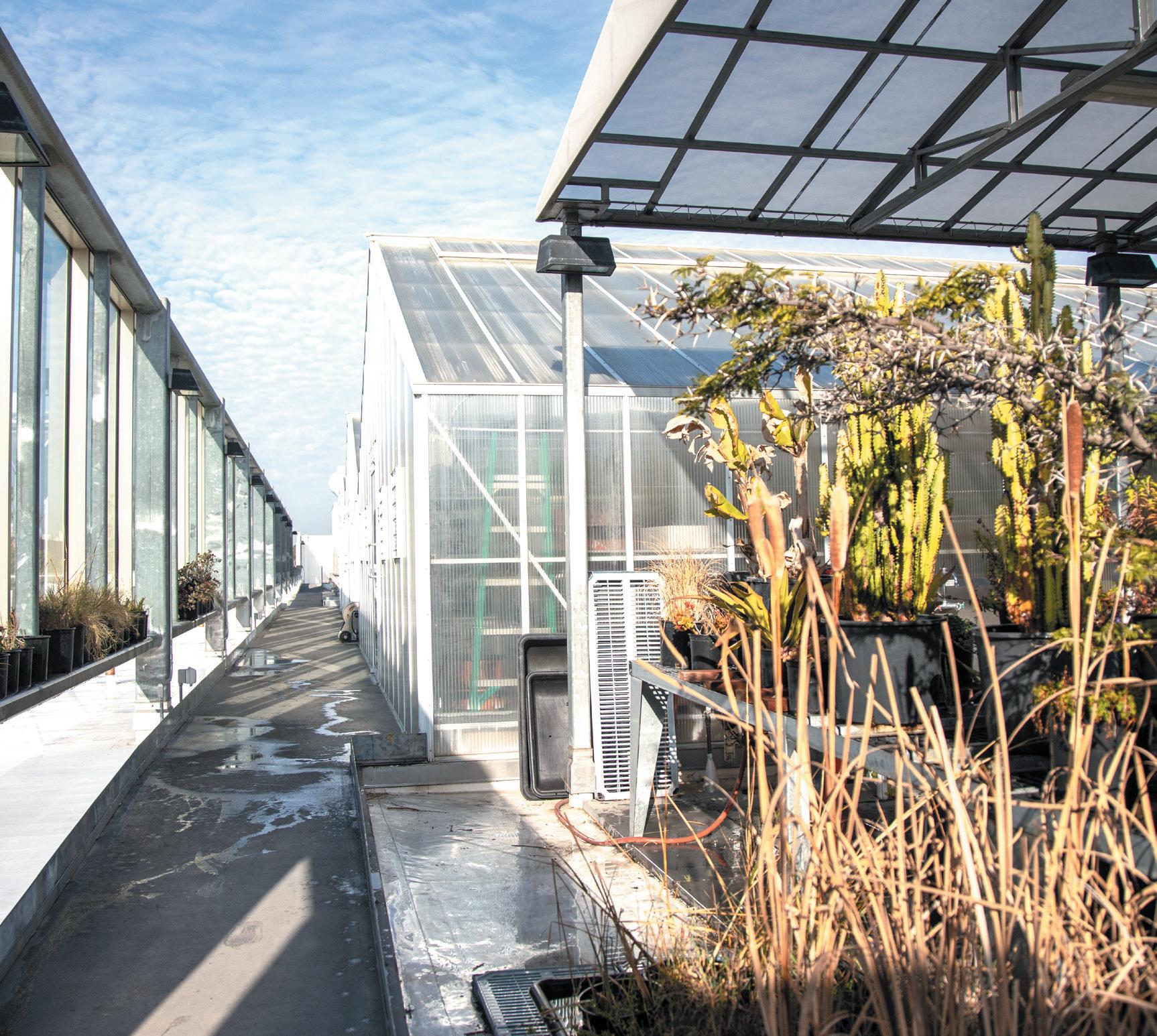
5 minute read
The virtual reality file
Alum with the REEN THUMB
CSULB is home to some of the world’s most exotic plant species, all which live in the greenhouses part of the botanical sciences department.
PHOTOS BY RYAN GUITARE
idden behind glass doors, some of the world’s most exotic plant species are cared for and tended to by Brian Thorson, botanical curator and botany tech- nician at Long Beach State. Each morning, he gets to campus as the sun rises to begin his daily routine of tending to the plants. The botanical sciences department has four greenhouses on campus. Three of them are located on top of the Hall of Science, and the fourth is tucked away on lower campus, hidden behind a brick wall next to the Facilities Management
Thorson completed his master’s degree in applied molecular systematics in 2005 at CSULB, but his passion has always lied in horticulture.
“I grew up in and spent my adolescent years in Guam,” Thorson said. “Our culture is really heavily influenced by our interactions with plants, and not just to eat but as building materials and for
Now 50 years old, Thorson remembers growing
“I’ve been growing plants since I was 6, so I’ve always had an interest,” Thorson said. “The more I learned about them the more fascinating they were
Thorson began tending to the greenhouses as a graduate student, and when his predecessor and former mentor retired, he was offered the job.
He said the greenhouses and growing grounds serve as a place for plants to grow for research and classroom use, as well as a reference collection for
The rooftop greenhouses are made with polycarbonate, which is highly effective for insulation, allowing the plants to stay at their designated temperatures for extended periods of
One of the houses on top of the HSCI is a tropical climate house, housing specific plants that prefer more humid living conditions. The others are much drier. The tempered house reflects the outside temperature, while the arid house mimics
The greenhouse located on lower campus is a more traditionally constructed unit made of single pane glass. Thorson said he has to work harder to keep those plants tempered properly because of
Thorson utilizes foggers in the tropical houses to create more moisture in the air for the plants that
The department houses well over 1,000 plant species from all around the world. Thorson finds new plants online, from fellow botanists and from his travels to add to the ever-growing collection.
As Thorson walks the rows of the greenhouses, he is able to identify the plant species, genus and native location with a simple glance.
One of the most expensive plants is the Welwitschia, which is native to the Namib Desert. Thorson has four total—two adults and two adolescents—and each sexually mature plant costs approximately $5,000 and each immature plant costs about $1,000.
Other unique species include Venus flytraps, Burseraceae trees, which produce sap and when extracted becomes frankincense, Crocus sativus, which produces saffron, and Vanilla planifolia, the plant that produces vanilla extract.
One of the most impressive residents in the collection is the Amorphophallus titanum, more commonly known as the “corpse flower.” Known for its intense odor, the corpse flower uses pheromones to attract pollinating flesh-eating bugs to spread its pollen to other corpse flowers. Last summer, both the male and female plants bloomed and were displayed for hundreds of visitors.
The greenhouses aren’t always accessible to visitors. Thorson said there’s too many risks involved with the placement of the greenhouse on an open rooftop. Thorny plants serve another risk, since they can cut and poke passersby. However, he isn’t always alone. Parker Richardson, a graduate biology student is Thorson’s assistant but didn’t always have a passion for plants like his mentor.
“My grandma was really into plants; she had this epic garden down in Oceanside where I grew up,” Richardson said. “So I’ve always loved plants, but I never really like taking care of them myself.”
Richardson is currently working on an experiment for his thesis about the germination rate of a seed under different salinities.
When he’s not working on his thesis, Richardson assists Thorson with anything that he needs, from watering to pruning plants and keeping the facility clean.
“Working with Brian, he has so much information, [and] I’ve been able to kind of pick his brain and really become more passionate about actually growing plants and taking care of them,” Richardson said.
Other students can use the greenhouse for their studies of plant ecology, genetics and morphology. Once their experimentation is over, Thorson takes over and continues to grow and cultivate the plants, adding them to the collection.
Part of the greenhouse’s purpose is to serve as a research facility for faculty as well.
Flora Banuett, professor of biological sciences, is currently working on research involving the inoculation of teosinte, or wild corn, to study the plant’s vitality and morphology. Thorson said the research may be used to develop a way to create antibiotics that would allow resistance to fungal infections in the human body.
When Thorson isn’t working in the greenhouses, he teaches future generations about the importance of plants and caring for them.
“When I came here, there was nothing,” Thorson said. “This whole collection I built myself … I just want to find somebody who will have the same passion that I do to continue my legacy.”

Amorphophallus tita- num in its leaf cycle, above, is a tropical plant native to Suma- tra and Borneo. This plant rarely blooms, but when it does the plant gives off the smell of decaying flesh, and is often called the corpse flower. Nepen- thes, left, also known as a tropical pitcher plant, is a carnivorous plant that collects enzymatic water to break down its prey to use as a food source. On the roof of the Hall of Science building, below, there are three green houses, tropical temprate and arid that house a multitude of plants.









